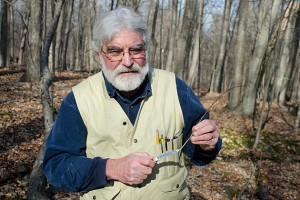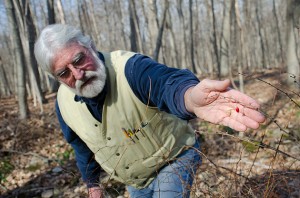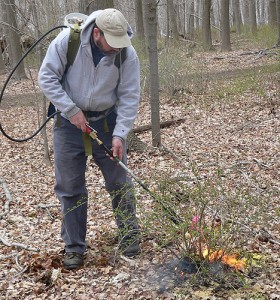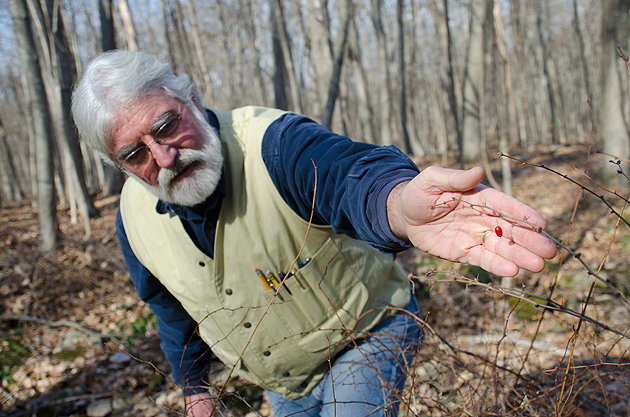
A nature-themed drama is unfolding in a corner of the UConn Forest in Storrs. The story contains elements of surprise as well as a glimpse of the region’s agrarian past.
The protagonist in the drama is the invasive Japanese Barberry (Berberis thunbergii), and Tom Worthley, assistant extension professor in the Department of Extension in the College of Agriculture and Natural Resources, provides a couple of interesting twists in the plot as he explains why eliminating the pest will also help control the spread of the tick-borne diseases of Lyme, granulocytic anaplasmosis, and babesiosis.
The UConn Forest as Laboratory
The forest landscape at the edge of the UConn campus replicates that which is found throughout New England. There, Worthley, along with colleagues Scott Williams, adjunct professor in UConn’s Department of Natural Resources and the Environment, and Jeffrey Ward, from the Department of Forestry and Horticulture at the Connecticut Agricultural Experiment Station in New Haven, are studying the problems brought about by the presence of this invasive species.
In a joint project funded in part by an innovation grant from the Natural Resources Conservation Service, part of USDA, the three researchers are attempting to find ways to return the forest ecosystem to its natural state.

Worthley explains that the Japanese Barberry was brought to this country because it is an attractive, hardy plant that requires little maintenance. It is deer-resistant and it thrives in old, abandoned farm fields that have reverted to woods, such as those found in the UConn Forest. For years the plant was considered to be a positive addition to the region’s rural and urban landscape.
Worthley says Barberry was introduced to the United States in 1875 but it wasn’t considered a problem until the 1980s, when it began to spread and take the place of native plants. Now it is found in 31 states. Connecticut is one of 17 states where it adapted to local conditions with such a vengeance that it is now considered invasive.
Adds Ward, “You can see how it crowds out native plants, but it also does something else that’s not so obvious to the casual observer. Most people are surprised to learn that earthworms aren’t native to New England. The Barberry creates a perfect environment for them, and then they eat the leaf litter that’s important in maintaining healthy hydrologic conditions. These worms have big appetites and when the litter layer gets eaten we see gullies forming, sediment washing into streams, soil chemistry changing … all sorts of negatives that you don’t see in a healthy forest ecosystem.”
In addition to attracting earthworms, the Barberry creates a perfect, humid environment for ticks. Williams recites the numbers. ”When we measure the presence of ticks carrying the Lyme spirochete (Borrelia burgdorferi) we find 120 infected ticks where Barberry is not contained, 40 ticks per acre where Barberry is contained, and only 10 infected ticks where there is no Barberry.”
Deer are often considered to be the prime source in spreading Lyme disease because they act as hosts to adult ticks; however they are not the only culprit in the forest. Since mice love the Barberry’s habitat as much as the hungry little arachnids do, they are an efficient vector for distributing immature ticks, those in their nymph stage, over a wide area.
And, although the prevalence of B. burgdorferi infection in adult ticks is twice that found in nymphs, it is estimated that nymphs are responsible for 90 percent of human disease transmission. This is due to their abundance, and because they feed in the summer when people are most apt to be involved in outdoor activities.
Putting Fire to Good Use
In order to change the dynamics, Worthley, Williams, and Ward have launched an educational effort that includes instructions for individuals, non-profits, and municipalities on how to get rid of the Barberry. They have given numerous field workshops and dozens of other consultations where they’ve discussed strategies for control, including mechanical mowing with a drum chopper or brush saw, the use of herbicides at appropriate levels, and the use of fire. It is the latter approach that garners the most attention.

Prior to European settlement in North America, low-intensity fires were a relatively common occurrence in upland forests, Worthley explains, and periodic burns were regularly set by Native Americans to control underbrush and stimulate sprout and berry growth.
Most of the native upland forest plant species evolved with fire present in the ecosystem, and developed adaptations to be able to regenerate successfully following low-intensity fires. Some non-native species, such as the Japanese Barberry, are not as well adapted to the presence of fire, so it is thought that the use of fire as a management tool can provide the native species with a competitive advantage.
Using propane torches to simulate the effects of fire, targeting the unwanted plants, is a technique being tried on Barberry. Worthley says that for plants that are up to three feet tall, a propane torch provides an effective, non-chemical alternative where herbicide use is restricted and where Barberry infestations are still light.
“We tell people that a propane torch is a powerful tool, and it’s similar to using a chain saw in terms of the damage it can cause if not used properly,” he says. “We don’t want people setting their woodlands on fire, so a torch should be used only when leaves are damp. Wear hearing protection, wear natural fibers [to avoid melted clothing], and exercise caution.”
Ward notes that since a propane torch is so effective in getting rid of Barberry, it can be a relatively low-cost investment for homeowners who want an herbicide-free way to keep ticks away from their kids and their pets.
Adds Ward, “This is public outreach at its best. It’s an opportunity for us to teach people about the complexity of our ecosystem, while giving them something concrete that they can do to help eliminate a genuine problem. Our research is productive … it has practical applications … and it’s fun, too.”



